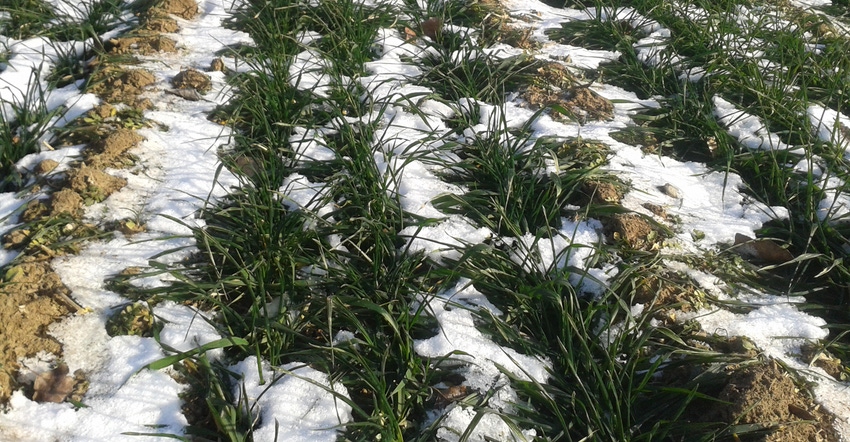December 4, 2018

By Deborah Jeanne Sergeant
Bob Walker, a self-proclaimed "city boy," wants to maintain profitability with what works: rotating corn and soybeans on most of his family's acres. Kristy Walker, who grew up on a farm, wants to improve the soil's health with cover crops and add small grains into the rotation.
"We're a house divided on our priority goal," Kristy Walker said, laughing.
The Walkers, who own Walker Homestead near Iowa City, Iowa, discussed their winter crop plans with Paul Ackley and others during a recent webinar, "Where to Begin With Winter Wheat Production," put on by Practical Farmers of Iowa and facilitated by Steve Carlson, next-generation coordinator for PFI.
Ackley farms 800 acres in Bedford, Iowa, and is commissioner of the Taylor County Soil and Water Conservation District. Practical Farmers provides farmer-to-farmer education through presentations, on-farm research and field days, workshops and other activities.
The Walkers began farming six years ago. They owned 5 acres and then purchased 80 more from a neighbor. Since then, they have started gardens, an orchard, a 2-acre vineyard, a winery, and pasture for heritage pigs, turkeys, goats, meat chickens and laying hens. They also raise rabbits, keep honeybees, and raise 4 acres of organic vegetables and half-an-acre of herbs and flowers.
Fifty acres of corn and soybeans are grown in rotation.
They also work outside jobs, which allows them to learn farming and occasionally make a few mistakes.
Bob said that between both, "there's a ton to learn and a ton of uncertainty."
Evaluating options
On crop rotations, they have evaluated rye cover crop, a winter wheat crop rotation and winter fallow with soybeans planted in spring.
They calculated cost of seed, labor for the steps they don't perform themselves and the price they could get: The Walkers would lose $1,712 planting a rye cover; lose $5,850 or possibly earn up to $6,650 with winter wheat; or earn $8,243 with a fallow winter followed by planting soybeans.
The figures don't include fertilizer or fungicide application.
"Some money is better than losing money," Bob said. "We had to figure out how we could make it in 50 acres."
Kristy thinks the rye cover will help improve soil health and organically manage weeds next season. She also likes the winter wheat for its ability to improve soil health, keep a living root system year-round to improve soil structure and provide income from a third crop in rotation.
Bob thinks a fallow winter followed by soybeans next spring is the least-risky option. It also means less labor and easier management.
In the end, Kristy won out. She wanted to plant 25 acres of winter wheat and 25 acres of rye cover crop.
Mother Nature steps in
But like many things in farming, Kristy's plans quickly changed.
The day after corn harvest, Nov. 17, she got seed and met with a contract farmer who said that his drill would not go through the corn stalks. Kristy shopped around for more help but eventually had to return the seed as no one was willing to try or was even available to help, as many farmers also experienced a late corn harvest.
"Like our turkeys, it was a beautiful idea, but as the big day approached it ended up on the butcher block," she said.
Ackley had some advice for the Walkers and anyone else in a similar predicament.
"Consider doing two or three practices on 50 acres," he said. "Start small. Do the income-producing thing for 45 acres of the 50. Consider cereal rye or triticale for the cash crop instead of winter wheat on 5 to 10 acres to get started. If there's horse people in the neighborhood, consider oats."
He added that since many horse owners buy in bulk to store up feed, it may be easier to sell oats quickly.
"Another possibility is a few acres of a heritage variety," he said. "The market is already into heritage breeds of turkey. That would go right along with it."
Looking to the future
Specialty crops in the rotation such as pumpkin or squash could also provide another revenue stream: Bringing people to the farm for agritourism.
But a farm tour he took a few years ago convinced him that cover crops are needed for healthy roots. A presenter on the tour, he said, pulled up a corn stalk that showed a healthy root mass.
"I noticed roots going down. Ours always went out,” he said. “They had a cover and rotated. It's a lot cheaper, it's a lot more fun, and you spend a lot less dollars and you make a more consistent yield."
Ackley said farmers, especially beginning farmers, should think about what they want their land to look like in 10 years. The Walkers are looking to add Scottish Highland cows and sheep to their farm, rotating them onto areas where they're growing cover crops.
"If you grazed grass-finishing animals, that would be a lot higher dollar value," Ackley said. "It definitely will turn things around faster than just a cover crop."
He also recommends planting small grains after a fallow winter.
Bob talked about 25 acres of oats and alfalfa, and 25 of soybeans next spring. Ackley called that "a good plan. You're not putting all your eggs in one basket. You'll have two crops to sell at two different times of year, which might be difficult, but you have good neighbors who want to learn along with you."
They're also kicking around the idea of heritage popcorn.
"For small farmers, doing value-added and direct sales to consumers may make more sense," Kristy said.
Sergeant writes from central New York.
You May Also Like




